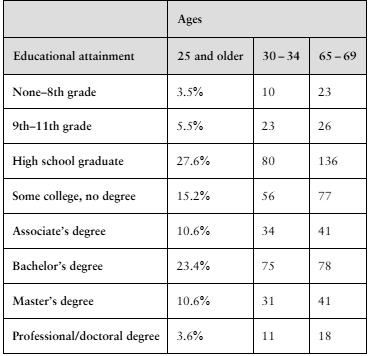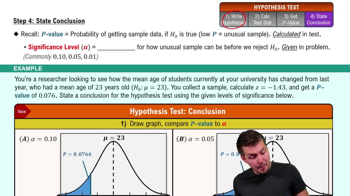You want your test to support a positive claim about your college, not just fail to reject one. Should you state your claim so that the null hypothesis contains the claim or the alternate hypothesis contains the claim? Explain.
Table of contents
- 1. Intro to Stats and Collecting Data1h 14m
- 2. Describing Data with Tables and Graphs1h 55m
- 3. Describing Data Numerically2h 5m
- 4. Probability2h 16m
- 5. Binomial Distribution & Discrete Random Variables3h 6m
- 6. Normal Distribution and Continuous Random Variables2h 11m
- 7. Sampling Distributions & Confidence Intervals: Mean3h 23m
- Sampling Distribution of the Sample Mean and Central Limit Theorem19m
- Distribution of Sample Mean - Excel23m
- Introduction to Confidence Intervals15m
- Confidence Intervals for Population Mean1h 18m
- Determining the Minimum Sample Size Required12m
- Finding Probabilities and T Critical Values - Excel28m
- Confidence Intervals for Population Means - Excel25m
- 8. Sampling Distributions & Confidence Intervals: Proportion1h 25m
- 9. Hypothesis Testing for One Sample3h 57m
- 10. Hypothesis Testing for Two Samples4h 50m
- Two Proportions1h 13m
- Two Proportions Hypothesis Test - Excel28m
- Two Means - Unknown, Unequal Variance1h 3m
- Two Means - Unknown Variances Hypothesis Test - Excel12m
- Two Means - Unknown, Equal Variance15m
- Two Means - Unknown, Equal Variances Hypothesis Test - Excel9m
- Two Means - Known Variance12m
- Two Means - Sigma Known Hypothesis Test - Excel21m
- Two Means - Matched Pairs (Dependent Samples)42m
- Matched Pairs Hypothesis Test - Excel12m
- 11. Correlation1h 24m
- 12. Regression1h 50m
- 13. Chi-Square Tests & Goodness of Fit2h 21m
- 14. ANOVA1h 57m
9. Hypothesis Testing for One Sample
Steps in Hypothesis Testing
Problem 10.Q.2b
Textbook Question
In each exercise,
b. find the critical value and identify the rejection region,
In Exercises 1 and 2, use the table, which lists the distribution of educational achievement for people in the United States ages 25 and older. It also lists the results of a random survey for two additional age groups. (Adapted from U.S. Census Bureau)

Use the data for 30- to 34-year-olds and 65- to 69-year-olds to test whether age and educational attainment are related. Use α=0.01.
 Verified step by step guidance
Verified step by step guidance1
Step 1: Define the null hypothesis (H₀) and the alternative hypothesis (H₁). H₀: Age and educational attainment are independent. H₁: Age and educational attainment are related.
Step 2: Choose the significance level (α = 0.01) and identify the test statistic to be used. In this case, use the chi-square test for independence.
Step 3: Calculate the expected frequencies for each cell in the table using the formula: E = (row total × column total) / grand total. This ensures the expected frequencies are based on the assumption of independence.
Step 4: Compute the chi-square test statistic using the formula: χ² = Σ((O - E)² / E), where O represents the observed frequency and E represents the expected frequency for each cell.
Step 5: Determine the critical value from the chi-square distribution table using the degrees of freedom (df = (number of rows - 1) × (number of columns - 1)) and the significance level α = 0.01. Compare the test statistic to the critical value to decide whether to reject or fail to reject the null hypothesis.
 Verified video answer for a similar problem:
Verified video answer for a similar problem:This video solution was recommended by our tutors as helpful for the problem above
Video duration:
3mPlay a video:
Was this helpful?
Key Concepts
Here are the essential concepts you must grasp in order to answer the question correctly.
Critical Value
The critical value is a point on the scale of the test statistic beyond which we reject the null hypothesis. It is determined based on the significance level (α) and the type of test being conducted (one-tailed or two-tailed). For example, with α = 0.01 in a two-tailed test, the critical values correspond to the extreme 1% of the distribution, indicating where the test statistic must fall to reject the null hypothesis.
Recommended video:

Critical Values: t-Distribution
Rejection Region
The rejection region is the range of values for the test statistic that leads to the rejection of the null hypothesis. It is defined by the critical values and represents the area in the tails of the distribution where the observed data would be considered statistically significant. In hypothesis testing, if the calculated test statistic falls within this region, we conclude that there is enough evidence to reject the null hypothesis.
Recommended video:
Guided course

Step 4: State Conclusion
Chi-Square Test of Independence
The Chi-Square Test of Independence is a statistical method used to determine if there is a significant association between two categorical variables. In this context, it can be applied to assess whether age groups and educational attainment levels are related. The test compares the observed frequencies in each category to the expected frequencies under the assumption of independence, providing a p-value to help make decisions about the null hypothesis.
Recommended video:
Guided course

Independence Test

 5:12m
5:12mWatch next
Master Intro to Hypothesis Testing with a bite sized video explanation from Patrick
Start learningRelated Videos
Related Practice
Textbook Question
37
views
